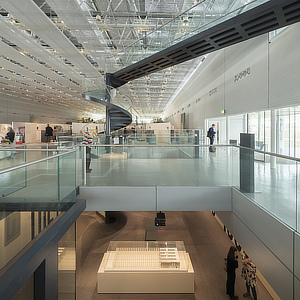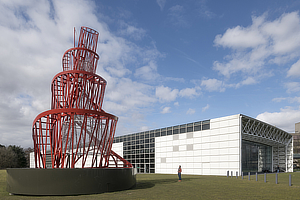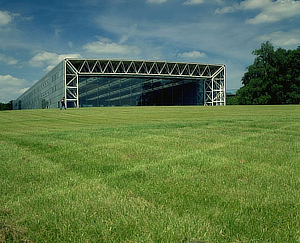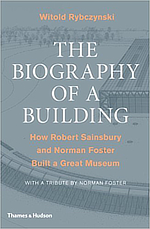 |
 |
 |
 |
 |
 |
| |
 |
|
 |
 |
 |
  |
  |
 |
 |
 |
 |
|
|
 |
|
 |
 |
 |
BUILDING |
 |
|
 |
|
 |
 |
 |
| |
 |
| 
 |
Sainsbury Centre for the Visual Arts
|
|
 |
 |
 |
 |
DESIGNER |
 |
|
|
 |
|
 |
 |
 |
| |
 |
|
 |
 |
 |
 |
CONTEXT |
 |
|
|
 |
|
 |
 |
 |
| Relationship with the location |
 |
|
 |
|
 |
 |
 |
 |
 |
 |
 |
DESCRIPTION |
 |
|
|
 |
|
 |
 |
 |
| Sainsbury Centre for Visual Arts celebrates its 40th anniversary |
 |
|
 |
 SUPERSTRUCTURES: THE NEW ARCHITECTURE 1960-1990 SUPERSTRUCTURES: THE NEW ARCHITECTURE 1960-1990
Sainsbury Centre for Visual Arts, Norwich
24 March – 2 September 2018
 Opened in 1978, the Sainsbury Centre for Visual Arts was the practice’s first cultural project, and one that embraced several themes that have remained at the core of our unique design approach – a strong belief in the integration of architecture and engineering, a commitment to low-energy, sustainable design, and a never-ending drive towards innovation. Opened in 1978, the Sainsbury Centre for Visual Arts was the practice’s first cultural project, and one that embraced several themes that have remained at the core of our unique design approach – a strong belief in the integration of architecture and engineering, a commitment to low-energy, sustainable design, and a never-ending drive towards innovation.
It was a project that challenged several existing preconceptions about museums, breaking the traditional mould with a ‘museum without walls’. The immense influence of its radical approach –the all-encompassing building envelope, its relationship with the surrounding landscape, and the pioneering principles of social integration – can still be seen in some of the practice’s most recent projects, such as the Mexico City International Airport, Apple Park and the recently opened Bloomberg Headquarters in London.
To mark the occasion the centre is hosting a major exhibition to shine a light on developments in architecture from the 1960s to the 1990s. Superstructures: The New Architecture 1960-1990 tells the story of architecture's fascination in the post-World War Two decades with new technology, lightweight structures, pioneering building techniques and innovative engineering solutions. |
|
 |
 |
 |
 |
 |
 |
 |
POINTS OF VIEW |
 |
|
|
 |
|
 |
 |
 |
| |
 |
 “The Sainsbury Centre was a pivotal project not just for what was a fledgling practice at the time, but as a complete reimagination of what a cultural institution could be. Everything was radical about it – from its location in the wilderness of the UEA campus, next to the science buildings to encourage cross-fertilisation, to the creation of a single enclosure that was a technological, ecological and social condenser. It was also a quest for beauty – to sit lightly and elegantly on its site with an interior that captured the landscape of its setting, the poetry of natural light, and above all a fitting setting for the Sainsbury’s magnificent collection.” “The Sainsbury Centre was a pivotal project not just for what was a fledgling practice at the time, but as a complete reimagination of what a cultural institution could be. Everything was radical about it – from its location in the wilderness of the UEA campus, next to the science buildings to encourage cross-fertilisation, to the creation of a single enclosure that was a technological, ecological and social condenser. It was also a quest for beauty – to sit lightly and elegantly on its site with an interior that captured the landscape of its setting, the poetry of natural light, and above all a fitting setting for the Sainsbury’s magnificent collection.” |
|
 |
 |
 |
 |
LOCATION |
 |
|
|
 |
|
 |
 |
 |

|
 |

|
Continent |
|
 |
  Europe |
|
Nation |
|
 |
  United Kingdom |
|
State |
|
 |
  England |
|
Region |
|
 |
  East |
|
County |
|
 |
  Norfolk |
|
District |
|
 |
  Norwich |
|
Town |
|
 |
  Norwich |
|
Address |
|
 |
  University of East Anglia (UEA) campus
|
|
|
|
 |
|
Telephone |
|
 |
|
Website |
|
 |
|
 |
 |
 |
 |
MAP |
 |
|
|
 |
|
 |
 |
 |
| |
 |
|
 |
 |
 |
 |
|
TYPOLOGY |
 |
|
|
 |
|
 |
 |
 |
|
|
 |
ARCHITECTURE | Museums and buildings for exhibitions
Art museums
Specialized museums
| |
 |
 |
 |
 |
CHRONOLOGY |
 |
|
|
 |
|
 |
 |
 |
Project |
 |
|
 |
| 
 |
1974
|
|
Realisation |
 |
|
 |
| 
 |
1975 - 1978 |
|
 |
 |
 |
 |
THE BUILDING IN CINEMA |
 |
|
|
 |
|
 |
 |
 |
| Title |
 |
|
 |
|
| Directed by |
 |
|
 |
|
| Nationality |
 |
|
 |
|
| Year of production |
 |
|
 |
|
| Cast |
 |
|
 |
| Robert Downey Jr., Chris Hemsworth, Mark Ruffalo, Chris Evans, Scarlett Johansson, Jeremy Renner, Don Cheadle, Aaron Taylor-Johnson, Elizabeth Olsen, Paul Bettany, Cobie Smulders, Anthony Mackie, Hayley Atwell, Idris Elba, Stellan Skarsgård, James Spader, Samuel L. Jackson |
|
| Building's role |
 |
|
 |
|
 |
 |
 |
|
 |
|
| Title |
 |
|
 |
|
| Directed by |
 |
|
 |
|
| Nationality |
 |
|
 |
|
| Year of production |
 |
|
 |
|
| Cast |
 |
|
 |
| Paul Rudd, Evangeline Lilly, Corey Stoll, Bobby Cannavale, Michael Peña, Tip "T.I." Harris, Anthony Mackie, Wood Harris, Judy Greer, David Dastmalchian, Michael Douglas |
|
| Building's role |
 |
|
 |
|
 |
 |
 |
|
 |
|
| Title |
 |
|
 |
| How much does your building weigh, Mr. Foster? |
|
| Directed by |
 |
|
 |
| Norberto Lopez Amado, Carlos Carcas |
|
| Nationality |
 |
|
 |
|
| Year of production |
 |
|
 |
|
| Cast |
 |
|
 |
| Norman Foster, Tony Hunt, George Weidenfeld, Richard Rogers, Bono, Deyan Sudjic, Paul Goldberger, Carl Abbott, Alain de Botton, Anish Kapoor, Richard Serra, Anthony Caro, Richard Long, Buckminster Fuller, Ben Cowd, Cai Guo-Qiang, Ricky Burdett, Spencer de Grey, David Nelson, Narinder Sagoo, Nigel Dancey, Loretta Law, Mouzhan Madidi, Stefan Behling, Jurgen Happ, Gerard Evenden
|
|
| Building's role |
 |
|
 |
|
| Annotations |
 |
|
 |
Producer: Elena Ochoa
Executive Producer: Antonio Sanz
Writer & Narrator: Deyan Sudjic
Music: Joan Valent
Director of Photography: Valentin Alvarez |
|
 |
 |
 |
 |
 |
 |
 |
BIBILIOGRAPHIC REFERENCES |
 |
|
|
 |
|
 |
 |
 |
|
 |
| Witold Rybczynski, "“The Sainsbury Centre represents a built chronicle of Norman Foster’s evolution as a designer.”. Biography of a Building", Architect 2/2016, february 2016, pp. 73-77 |
|
|
 Witold Rybczynski, The Biography of a Building. How Robert Sainsbury and Norman Foster Built a Great Museum, Thames & Hudson, London 2011 Witold Rybczynski, The Biography of a Building. How Robert Sainsbury and Norman Foster Built a Great Museum, Thames & Hudson, London 2011 |
|
|
| Materia 32, maggio-agosto/may-august 2000 [Architettura dei luoghi di lavoro / Architecture of workplaces], pp. 88 (86-91) |
|
|
| Giuseppe Zampieri, "Foster in Gran Bretagna / Foster in Britain", Domus 825, aprile/april 2000, "itinerario/Itinerary 166" n. 3 (pp. 120-128) |
|
|
| Lotus international 99, dicembre/december 1998 [Forma e struttura / Form and Structure], pp. 26 (24-31) |
|
|
| Lotus international 78, ottobre/october 1993, [Applicazioni tecniche / Technical Applications], pp. 78 (66-79) |
|
|
| Bruno Zevi, Spazî dell'architettura moderna, Einaudi, Torino 1973, tav. 683 [XII. La terza età: itinerarî degli anni cinquanta-ottanta] |
|
 |
 |
 |
 |
 |
 |
 |
CLIENT |
 |
|
|
 |
|
 |
 |
 |
| |
 |
| University of East Anglia |
|
 |
 |
 |
 |
STRUCTURES |
 |
|
|
 |
|
 |
 |
 |
| |
 |
|
 |
 |
 |
 |
LANDSCAPE DESIGN |
 |
|
|
 |
|
 |
 |
 |
| |
 |
|
 |
 |
 |
 |
STAFF |
 |
|
|
 |
|
 |
 |
 |
Project  |
 |
|
|
 |
|
 |
 |
 |
 |
CREDITS |
 |
|
|
 |
|
 |
 |
 |
| |
 |
Photos © Nigel Young | Foster + Partners
Text edited by Foster + Partners
Courtesy of Foster + Partners
|
|
 |
  |
 |
|
|